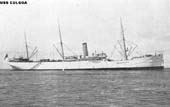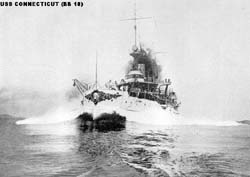 |
Stores Ship Culgoa
Lt. Commander John B. Patton
Culgoa was built for commercial service in 1889. After
being purchased by the Navy, she served in the western
Pacific area until 1901, then shifted to the Atlantic, where she served
for most of her career. She decommissioned in 1921 and sold in the following year.
|
 |
 |
Stores Ship Glacier
Commander William S. Hogg
Glacier was built for commercial service in 1891, named
Port Chalmers, and was renamed Glacier soon after the Navy
purchased her. She was detached from the Great White Fleet at Cavite in
October 1908,
and served primarily in the Pacific for the remainder of her career.
The old ship was decommissioned in 1922, and sold the same year.
At right: A boat and crew from Glacier.
|
 |
 |
Repair Ship Panther
Commander Valentine S. Nelson
This ship started life as a passenger liner named Austin, and was
acquired by the Navy as an auxiliary cruiser. After the war most of her
time was spent in reserve
and as a station ship before being outfitted as a repair ship for the
world cruise. She finished life as a destroyer tender, and was sold in
1923. At right: Panther's machine shop crew. |
 |
 |
Yacht Yankton
Lt. Walter R. Gherardi, later Lt.
Commander Charles B. McVay
This yacht, although of no military use whatsoever, was brought along
for use in ceremonies and as a status symbol. She had been built as the
yacht Penelope in 1893, and was purchased by the Navy in 1898 as a
patrol ship. She was sold into commercial service
in 1921, spent time as a rumrunner, and was eventually scrapped in 1930.
|
 |
 |
Hospital Ship Relief
Surgeon Charles F. Stokes
Built as the passenger liner John
English, this ship was purchased by the Army for service as a hospital
ship in 1898. She was transferred to the Navy in
1902 and was recommissioned in 1908 to support the world cruise. She
joined the fleet in California early in 1908, but only made it to the
Philippines before being detached in November 1908. Damaged by a storm
while attempting to return to the US, she spent the next 11 years at
Olongapo, PI, as a stationary floating hospital, eventually renamed
Repose. Sold into merchant service in 1919, she apparently became
a war loss during WWII.
|



